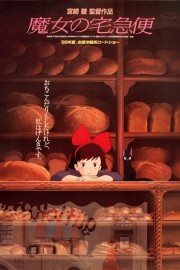Kiki’s Delivery Service
In the films of Hayao Miyazaki, fantasy exists hand-in-hand with the real world, being infused by it while grounding the stories in some physical and emotional reality. I wonder whether that might also be part of the appeal of Harry Potter, which still finds Harry having to end up back at the Dursley’s as each year ends.
Of all of the films of Miyazaki’s I’ve seen, his 1989 film “Kiki’s Delivery Service” is the least fantastic, in the sense that it’s grounded more firmly in our reality than any other of his films. That doesn’t make it any less wonderful. If anything, it’s more wonderful because of it. And like his 2002 masterpiece “Spirited Away,” it’s the story of a young woman’s growing up in a world that forces her to do so earlier than she’d like.
Kiki is a young witch of 13. By tradition, whenever a witch turns 13, she must go out into the world for a year. It’s a rite of passage where she must find her way. At the start of the film, she decides that it’s time for her to go on her journey. With her trusty, sardonic black cat Jiji, she goes off on her mother’s broom to fly off into the world.
She ends up in an ocean-side town. Her first impression isn’t really the greatest, though- she almost causes a traffic accident when she loses control of her broom. But she catches the eye the young Tombo, and gains the favor of a bakery owner when she delivers a pacifier to a woman who forgot it. After that, she realizes that a delivery service would be where she could find her way.
The adventures she has with Jiji are the bulk of the story. It’s been a lot of years since I first watched the film, but one sequence struck me as being key, to the film and to Kiki’s character in particular. She’s paid for a delivery of a bird cage and cat stuffed toy to a woman’s nephew. Along the way, the wind causes her to lose control, falling in the forest. Kiki and Jiji get back off the ground, but realize that the toy is gone. Buying time for Kiki to go back and find it, Jiji takes its’ place. It’s hard not to feel worried for him, especially when we discover the nephew’s family has a dog.
Kiki goes back into the woods. She finds the toy in the window sill of a cabin in the woods. At first, it seems empty. It would be very easy for her to just take it, but when she discovers the owner on the roof- a young artist- they trade favors, and become friends. And it turns out, the dog isn’t as dangerous as Jiji thought, coming in handy when a switch needs to be made.
At one point, Kiki loses her witchy powers. Jiji- who has a girlfriend at this point- sounds like another cat, and she’s unable to fly, breaking her broomstick when she tries to fly. She makes another one, but it’s not until she takes a retreat with her artist friend, and makes a return trip to an elderly client’s house, that she comes to see the thing she’s missing in her life.
But I’ll let Miyazaki take it from there. His is one of the few genuine “brand names” among Anime directors- I’d include Shinichiro Watanabe (“Cowboy Bebop”), Satoshi Kon (“Perfect Blue”) and Katsuhiro Otomo (“Akira”) as the others- in an animation style that’s as versatile and imaginative as any in the world. He has continued to hand-draw the thousands of cels his films require himself- although since his 1997 film “Princess Mononoke,” he has begun to employ computers- as well as hold true to a simple principle of filmmaking- “If you haven’t got the story, you haven’t got anything.”
Based on an original story by Eiko Kadono, Miyazaki’s lovely screenplay keeps the focus on Kiki and her journey of self-discovery, but Miyazaki has a secret weapon behind the screens. His name is Joe Hisaishi, and his scores for Miyazaki’s films lift our emotions as well as engage us in the narrative, even when Miyazaki’s main characters are at their lowest.
Kiki gets pretty low in this film. Her situation seems pretty hopeless. But Miyazaki is as good as anybody when it comes to staying true to his world while allowing for a happy ending. And “Kiki’s Delivery Service” probably has his most uplifting ending. While some of his more recent ventures have gone into more adult territory, “Kiki’s Delivery Service” remains a family favorite, and in a way, still the gold standard in how to treat an audience- young and old- with intelligence and heart. No wonder Pixar’s John Lasseter considers him the master of the art form- it’s a template his own studio has used in every film of their own over the years.










